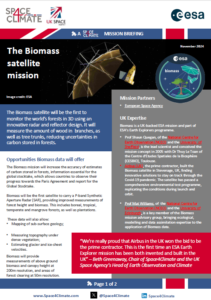BIOMASS is the first satellite that will study the world’s forests in 3-dimensions using a P-band tomographic radar.
At COP26, over 100 world leaders promised to end and reverse deforestation by 2030. This will stop the conversion of forest biomass (50% carbon) into atmospheric CO2 when forests are destroyed. Retainment of forest biomass is vital for the pull-down of CO2 from the atmosphere in order to store carbon in growing trees (and soil).
The BIOMASS mission will demonstrate how we can measure these changes in stored carbon in the lead-up to 2030. Its lifetime of 5 years (from launch in 2025) means it that it will help us to track progress towards this commitment. Whilst it won’t be in place in 2030, it will be the forerunner to a set of operational satellites addressing this crucial climate issue.
Mission facts
- Global coverage
- Forest above ground biomass: 200m resolution
- Canopy height: 200m resolution
- Area of forest clearing: 50m resolution
- One map every 6 months for 4 years
- Unprecedented accuracy
Application
BIOMASS is the first satellite that will study the world’s forests in 3-dimensions using a P-band tomographic radar. Scheduled for launch in Spring 2025, it will reduce the current huge uncertainties in the amount of carbon stored in forests and how this changes with time, providing vital information to support decision making around climate change.
Observations from this new mission will also lead to better insight into rates of habitat loss and, hence, the impact this may be having on biodiversity in the forest environment.
UK expertise
UK industrial experience in building satellites and designing radars is being put to work for the European Space Agency to develop its BIOMASS mission.
Professor Shaun Quegan, of the University of Sheffield and the National Centre for Earth Observation (NCEO), first developed the concept for the mission, which was proposed in 2005, and he leads the mission’s scientific team. His NCEO colleague Professor Mat Williams, at the University of Edinburgh, is a key member of the BIOMASS Mission Advisory Group bringing ecological, modelling and data assimilation expertise to the application of BIOMASS data.
Find out more about the science behind the Biomass Missions:
Airbus reported that, despite the impact of Covid-19 restrictions, integration of the hardware onto the Structure Model Platform was completed in January 2021.
Airbus is incorporating BIOMASS activities into its Stevenage Discovery Space STEM Centre, backed and funded by Airbus, the Airbus Foundation and the Hertfordshire Local Enterprise Partnership, and operated by North Hertfordshire College. The Centre was opened by British astronaut, Tim Peake, in 2017.

Read more:
- ESA: Introducing Biomass
- UK Space Agency: Biomass case study
- Airbus: Biomass forest sensing satellite shaping up
- ITV News: New satellite aims to help see the forest for the trees
- University of Sheffield: How to weigh a forest from space

